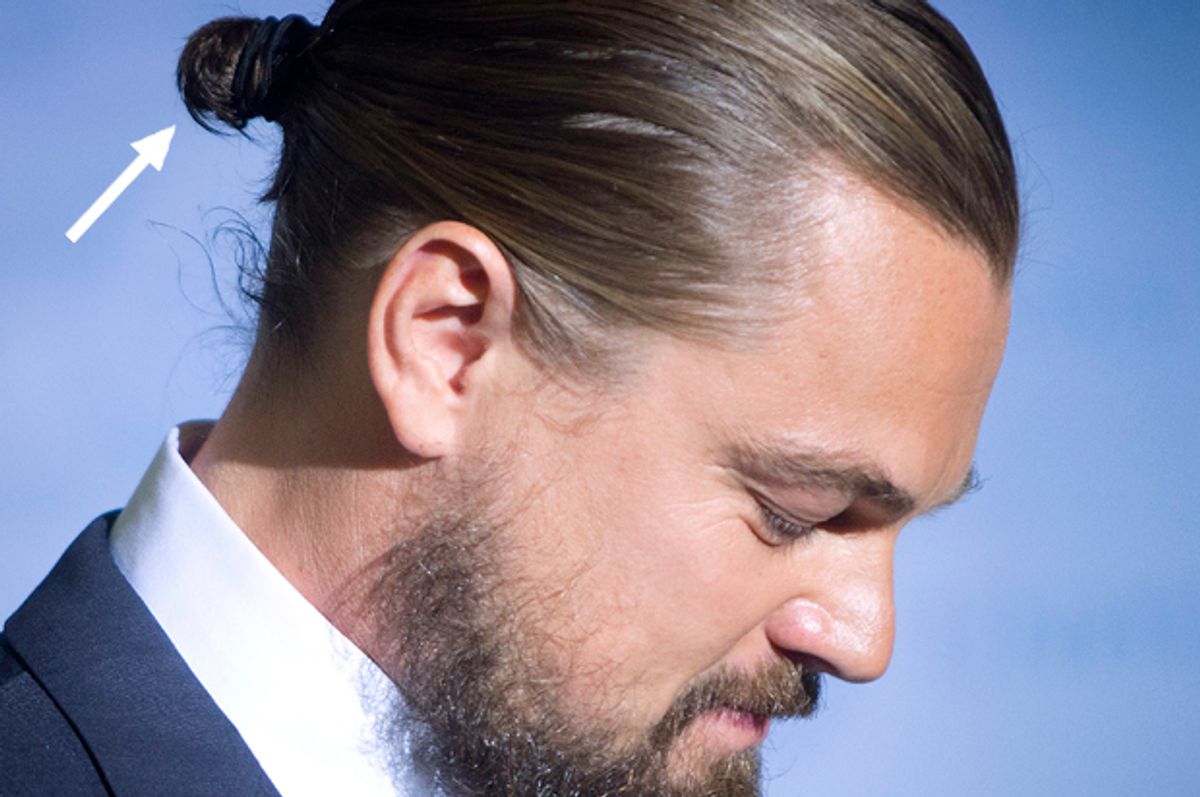I didn’t have much hair until I was about four years old, seriously. My parents joke about their bald baby — my mom would tape hair bows onto my otherwise-barren scalp. When I was about six or seven, I had my first series of dance recitals. In order to achieve a uniform look for the wee dancers, we were all required to wear chignon-shaped hair pieces. I remember feeling like the most potent pint-size ballerina at the recital. I was wearing tutu and lipstick, and for the first time in my life had an impressive display of hair (or at least the illusion of it). I knew this new ‘do, no matter how temporary, meant business. Heavy lies the head.
I outgrew the need for hairpieces, but had many friends in high school and college who regularly went to the salon for hair extensions. It never seemed like a big deal — just another routine grooming ritual.
This year, one of the most dominant trends in male hair has been “the man bun,” popularized by the likes of Jared Leto and Leo DiCaprio. The style used to be associated with grungy rockers who tossed up their hair before a set (or maybe once they ran out of dry shampoo), but the trend’s explosive popularity prompted research on the potential risks of such a dangerously-cool ‘do for dudes.
The hairstyle has been linked to traction alopecia, a condition that leads to early hair loss and baldness around the temples and forehead due to unnatural pressure near the areas from the hair and skin being pulled too tightly. The same thing can happen to women who wear too-tight braids, pony tails, and yes -- buns.
But technology has found a solution to this problem by introducing clip-on man buns, currently available for a deal on Groupon.
I can understand the appeal. I have guy friends who’ve expressed interest in wanting to sport the popular style. It makes sense to me that someone who doesn’t have the proper length, or maybe the interest in fully committing to the style, might want to try out a removable version. I mean, I still love playing dress up and experimenting with different styles.
I admit, it’s a silly product. But the same level of seeming absurdity can be attributed to regular Brazilians, blow outs and gel manicures.
The public, however, seems to find the clip-in man bun entirely repugnant.
I think once the shock of the product wears off, people are going to be less inclined to care about clip-in hair products for men. Years ago, the man bag or “murse” attracted similar attention before everyone seemed to agree that guys need something to hold their stuff too.
But why is it such a big deal?
A male friend of mine is always on trend when it comes to his hairstyle. I regularly see him rocking a perfectly coiffed chignon near the crown of his head. Ask him about, and he’ll tell you it’s not a man bun. It’s a not a clever reference to Magritte’s “The Treachery of Images,” but a little more practical. By his description, it’s quite simply a “bun.”
The language we use reflects our culture’s subconscious associations with the words. In terms of linguistics, gender-specific pronouns are typically assigned to words we normally associate with the opposite gender. Words like “male nurse,” “female pilot,” “manny” for “male nanny,” and “woman CEO.” The pronominalization of the words occurs when “he” or “she” is used to describe occupational terms. The same linguistic phenomenon is beginning to emerge in products designed for men that used to be exclusive to women.
The Sapir-Whorf hypothesis holds that a word doesn’t exist unless the concept does — see the often-repeated detail that the Eskimo family of languages has so many words for “snow.” The language supports the cultural belief that there are many different types of snow (concept), which therefore require unique descriptors (the words). Because of the way language influences culture, we tend to be subject to the built-in stereotypes our language assumes.
The concept of a bun worn by men is, like the "man bag," still feels transgressive from a gender norm perspective, so we have to find a unique term for a guy pulling his long-ish hair up off his neck in this specific way. We live in a culture that encourages men to be both traditionally masculine and fashion forward. Women can relate to having to reconcile similar dichotomies, of course, so a step in the right direction might be to consciously remove gender-specific pronouns from our lexicon. I’m not sure if the clip-on man bun will stick as a lasting product, but I do think it’s a product people are going to be tempted to try, regardless of gender.

Shares